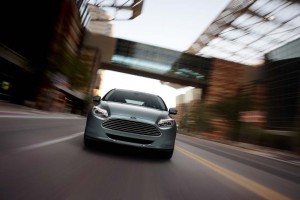
Ford's Focus Electric will be one of 159 battery-based vehicles on the U.S. market by 2016 - but will car buyers care?
Despite the endless headlines and the steady roll-out of battery cars, plug-ins, hydrogen vehicles and natural gas-powered sedans, the market for alternative powertrain vehicles is likely to remain extremely limited for some years to come, warns a new study that predicts “automakers will be fighting over the relatively few consumers who are willing to drive green.”
Though large numbers of U.S. car buyers might say they want a clean vehicle, cost and convenience matter more than the environment when it comes time to buy, concludes the Green Automotive Study released today by J.D. Power and Associates.
“It is the financial issues that most often resonate with consumers, whether it is the higher price of the vehicle itself, the cost to fuel or charge the vehicle, or the fear of higher maintenance costs,” said Mike VanNieuwkuyk, Power’s executive director of global vehicle research. “The bottom line is that most consumers want to be green, but not if there is a significant personal cost to them.”
By 2016, Power forecasts there will be 159 hybrid and electric vehicle models available in the U.S., a more than fivefold increase from the 31 marketed in 2009. But they’re collectively expected to account for just 10% of the total U.S. automotive market.
Building demand to support that range of new offerings will likely require corporate and government education efforts – along with continuing subsidies, such as the $7,500 federal tax credit available for the Nissan Leaf battery-electric vehicle and Chevrolet Volt plug-in hybrid.
Range anxiety is clearly an issue, according to most research, though government data suggests that a 40-mile plug-in like Volt could handle the daily commute for 70% of American consumers, while the 100-mile Leaf would cover daily needs for an even greater percentage of U.S. motorists. But Americans typically purchase vehicles with the expectations they can handle their most extreme needs, such as being able to handle the once-a-year family vacation trip.
Cost is an even greater issue, Power’s Green Automotive Study suggests. It finds that 75% of consumers would consider a battery-based vehicle if it could reduce their fuel bills. Only 50% told researchers they would go for such a vehicle because it would be “better for the environment.”
But despite $4-a-gallon gas, the savings do not appear to be overcoming the higher initial premium for vehicles like Volt, Leaf or the Toyota Prius – though the latter is the nation’s best-selling hybrid it accounts for less than 1% of total U.S. new car sales.
“Vehicle price has become more prevalent as the primary purchase impediment,” said VanNieuwkuyk. “Without a tax credit to offset the price premium, consumers must absorb all of this additional cost. Furthermore, aggressive government subsidies are unlikely to be sustainable over the long term. Ultimately, the true cost of the technology needs to come down substantially.”
Indeed, many state governments are beginning to question whether they need to add taxes on green products, like Prius or Volt, to recover lost fuel excise taxes. One such measure is now under consideration in Washington State.
The first test of how consumers will accept advanced battery vehicles is now underway. So far, however, sales of the Leaf and Volt can be measured in the low thousands. But the makers insist that is due to slow production starts, so any real measure of demand won’t become apparent until later this year.
Battery vehicles aren’t the only green machines struggling for acceptance, Power’s Green study cautions. There’s been an equally slow ramp-up of demand for so-called “clean diesel” technology, which is currently offered by only a handful of makers, most of them European.
“Clean diesel technology continues to struggle not only against concerns about cost and perceived fuel availability, but also against the lingering perception that diesel is ‘dirty,’” said VanNieuwkuyk.
The U.S. isn’t the only market where advanced propulsion is facing an uphill battle, industry research illustrates. But regulators in several parts of the world may provide the impetus to boost sales. Chinese and European officials are looking at new rules that could effectively force a market shift to battery power over the next few decades despite the limits of the technology – or consumer resistance.
